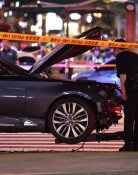IAEA Suspects Iraq on Nuclear Weapons Development.
IAEA Suspects Iraq on Nuclear Weapons Development.
Posted August. 28, 2003 22:13,
Dispute over Irans nuclear weapons development is heating up once again as the International Atomic Energy Agency (IAEA) found two different types of highly enriched uranium particles at atomic-energy-related facilities in Iran.
Iran is one of the countries referred to as an axis of evil along with North Korea by US President George W. Bush. Now as the news erupts while the United States is participating in the 6-way talks to resolve North Koreas nuclear crisis, much attention is being paid to the response of the United States which brought about war against Iraq blaming its production of weapons of mass destruction.
The IAEA found the particles at uranium processing facilities in Natanz, south of Irans capital Tehran. The two particles are not necessary making nuclear power, a western foreign diplomat said, raising its suspicion.
Iran, however, reputed such accusation, claiming The facilities in Natanz are merely plants for enriching uranium to supply to nuclear power plants. What they produce is not enriched enough for making nuclear weapons.
A heavy water reactor that is being built in southwest Tehran is also a target of suspicion since heavy water can be used as a coolant for producing highly enriched uranium or plutonium. Some pundits believe an electric plant in Kalaye may be a nuclear-material-enriching facility.
Iran is currently building a nuclear energy plant in Beushir with Russias support. One 1,000MW plant is about to be completed and Iran is planning to build another 13,000MW plant soon. Uranium is planned to be supplied to the plants by Russia.
Besides the plants, Iran is also operating atomic reactors for academic purposes at the University of Tehran and the Ispan Nuclear Research Center. Even though they are reactors for academic purposes, they are also the subjects of inspection by the IAEA. Pundits claim that the Ispan Research Center and Technical University of Shaf are, respectively, capable of designing nuclear weapons and extracting plutonium.
Concerns over Irans nuclear development reached its climax in early July when it succeeded in launching a Shab-3 missile that had a range of 1,500km. Shab-3 missiles have many similar features to the Daepodong 1 of North Korea and can carry around 1,000kgs of warhead. Conservative members of the Congress in the United States believe that if Iran is undeterred in developing its nuclear programs, Iran is likely to cooperate in producing nuclear weapons with Saudi Arabia and Pakistan which, respectively, possess long range missiles and nuclear weapons. Pundits also suggest that Iran will stimulate both Syria and Egypt, which have ambitions to build nuclear fuel reprocessing facilities, to develop nuclear weapons.
Officials of the IAEA inspected Iran 5 times since June and will submit results September 8 to the board of the IAEA. The IAEA inspectors, however, claim that Iran neither provided enough information nor allowed them to inspect suspected facilities.
The IAEA is demanding Iran sign an annex of the Nuclear Nonproliferation Treaty (NPT) that will allow random inspection.
Iran, however, claims that its nuclear facilities are being developed for peaceful purposes (electricity) and is demanding western countries provide technical support in constructing nuclear plants on condition of signing the annex.
The United States is also demanding Russia halt its support in developing Irans nuclear facilities. In addition, the European Union, including Britain are threatening Iran that they will push economic sanctions and Japan is also pressuring Iran saying it will withdraw its 2 billion aid in developing an oil well in Ahadejan.
Jin Lee leej@donga.com







